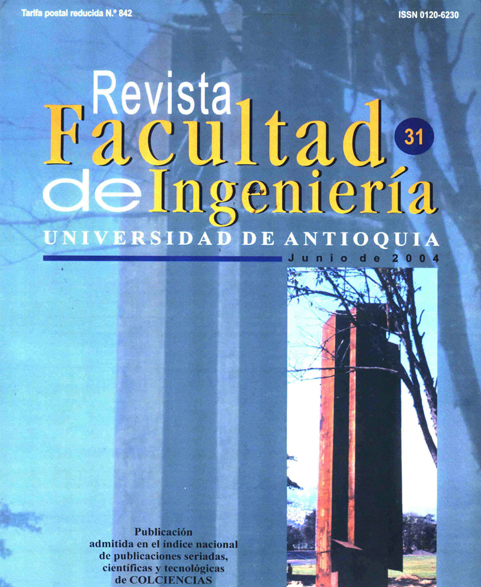Producción limpia de metil etil cetoxima (MEKO)
DOI:
https://doi.org/10.17533/udea.redin.344499Palabras clave:
Amoximación, metil etil cetoxima, TS-1, catalizadoresResumen
Se obtuvo la metil etil cetoxima (MEKO) mediante la reacción de metil etil cetona (MEK) con amoníaco y peróxido de hidrógeno, utilizando como catalizador titanio silicalita-1 (TS-1). Se analizaron las siguientes variables de reacción: solvente, temperatura, relaciones molares peróxido de hidrógeno/MEK y amoníaco/MEK, así como la relación mg. de catalizador mg/mmol MEK. Entre los solventes utilizados: agua, agua-isopropanol, isopropanol, acetonitrilo y benceno, se encontró que el primero es el solvente que más favorece la reacción. Se obtuvo una conversión de 60% y una selectividad de 100% a 70 °C usando relaciones mg catalizador/mmol MEK = 10,5 y relaciones molares de peróxido de hidrógeno/MEK = 0,7 y amoníaco/MEK = 1,12. La actividad del catalizador disminuyó poco al reutilizarse en dos corridas consecutivas, lo que sugiere que el titanio incorporado es estable en la estructura MFI bajo las condiciones establecidas.
Descargas
Citas
Notari. “Titanium silicalites”. En: Catalysis Today. Vol. 18. 1993. pp.163-172. DOI: https://doi.org/10.1016/0920-5861(93)85029-Y
R. Sheldon and J. Dakka. “Heterogeneous catalytic oxidations in the manufacture of fine chemicals”. En: Catalysis Today. Vol. 19. 1999. pp. 215-246. DOI: https://doi.org/10.1016/0920-5861(94)80186-X
R. Sheldon. “Selective catalytic synthesis of fine chemicals: Opportunities and trends”. En: Journal of Molecular Catalysis A: Chemical. Vol. 107. 1996. pp. 75-83. DOI: https://doi.org/10.1016/1381-1169(95)00229-4
h t t p : / / w w w . d u r a c h e m i c a l s . c o m / Antiskinningagents.htm.
G. Petrini et al. “Caprolactam via ammoximation”. En: Presented in the worldwide solid acid process conference. 1993.
A. J. H. P Van der Pol and J. H. C Van Hoof. “Parameters affecting the synthesis of titanium silicalite”. En: Journal Applied Catalysis A: General. Vol. 92. 1992. pp. 93-111. DOI: https://doi.org/10.1016/0926-860X(92)80309-Z
P. Roffia et al. U.S. Pat. 4.794.198 (1998).
T. Takashi and N. Jappar. “Ammoximation of cyclic ketones on TS-1 and amorphous SiO2-TiO2”. En: Journal of Catalysis. 1996. pp. 570-576. DOI: https://doi.org/10.1006/jcat.1996.0219
P. Wu et al. “Ammoximation of ketones over titanium mordenite”. En: Journal of Catalysis. Vol. 168. 1997. pp. 400-411. DOI: https://doi.org/10.1006/jcat.1997.1679
M. A. Mantegazza et al. “Selective oxidation of ammonia to hydroxylamine with hydrogen peroxide on titanium based catalysts”. En: Studies in Surface Science and Catalysis. Vol. 82. 1994. pp. 541-548. DOI: https://doi.org/10.1016/S0167-2991(08)63447-3
A. Zecchina et al. “Ammoximation of cyclohexanone on titanium silicate: investigation of the reaction mechanism”. En: Proccedings of the 10th International Congress on Catalysis. 1992. pp. 19-24.
G.P. Heitman et al. “Modified Beta zeolites as catalysts for the Beckmann rearrangement of cyclohexanone oxime”. En: Applied Catalysis A: General. Vol. 185. 1999. pp. 99-108. DOI: https://doi.org/10.1016/S0926-860X(99)00126-X
Descargas
Publicado
Cómo citar
Número
Sección
Licencia
Los artículos disponibles en la Revista Facultad de Ingeniería, Universidad de Antioquia están bajo la licencia Creative Commons Attribution BY-NC-SA 4.0.
Eres libre de:
Compartir — copiar y redistribuir el material en cualquier medio o formato
Adaptar : remezclar, transformar y construir sobre el material.
Bajo los siguientes términos:
Reconocimiento : debe otorgar el crédito correspondiente , proporcionar un enlace a la licencia e indicar si se realizaron cambios . Puede hacerlo de cualquier manera razonable, pero no de ninguna manera que sugiera que el licenciante lo respalda a usted o su uso.
No comercial : no puede utilizar el material con fines comerciales .
Compartir igual : si remezcla, transforma o construye a partir del material, debe distribuir sus contribuciones bajo la misma licencia que el original.
El material publicado por la revista puede ser distribuido, copiado y exhibido por terceros si se dan los respectivos créditos a la revista, sin ningún costo. No se puede obtener ningún beneficio comercial y las obras derivadas tienen que estar bajo los mismos términos de licencia que el trabajo original.










 Twitter
Twitter